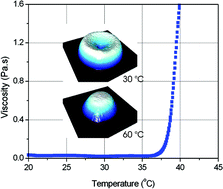When an inkjet printed feature is formed, the behaviour of the ink on the substrate is of great importance. In order to investigate the possibility of increased control over the as-printed feature on a substrate, a TiO2 ink was formulated that gels above a certain temperature. The TiO2 particles in the ink are colloidally stabilised by an adsorbed layer of poly(vinyl methyl ether)-block-poly(vinyloxy-4-butyric acid) diblock copolymer. The thermal gelation, at about 37 °C, is due to the limited solubility of the poly(vinyl methyl ether) buoyant block in the continuous medium of the ink. Drops and lines with improved morphological control and resolution were achieved using the thermal gelation effect. Lines printed using this approach did not display deviations at their starts and ends; and bulges in the line could be avoided. Finally, defect-free straight lines could be printed on very hydrophobic surfaces, which is impossible with regular inks due to the de-wetting nature of such substrates.

You have access to this article
 Please wait while we load your content...
Something went wrong. Try again?
Please wait while we load your content...
Something went wrong. Try again?


 Please wait while we load your content...
Please wait while we load your content...